The next day we farewelled the Dumaresques – with invitations to come north and let us repay their hospitality -and set off for New Norfolk. The plan was to visit the Rosedown Gardens, drop in to see Dinie Mills (George and Martin’s aunt) and make our way down to Cygnet and Helmsman’s House, our B&B for the next three nights.
We had a lovely drive along the Derwent River and arrived in the historic pioneer town of New Norfolk. Many of the pioneers who settled around the town were from those resettled when the first Norfolk Island settlement was closed. These Norfolk Islanders were mainly farming families, who were offered land grants in Tasmania as compensation for their relocation.
The climate was colder than sub-tropical Norfolk Island, which proved a challenge for the hardy pioneers during the first few years, but eventually the district became self-supporting. In 1825 the original name of the town, Elizabeth Town, was changed to New Norfolk in honour of their former home.
Many of the founders were “First Fleeters”, transferred from Sydney to Norfolk Island when it was settled just a few weeks after Sydney. Ten First Fleeters are buried in the Methodist Chapel at Lawitta, New Norfolk. Notable is Betty King, née Elizabeth Thackery. The headstone on Betty’s well-tended grave reads, “The first white woman to set foot in Australia” from the First Fleet at Sydney Cove.
On Wednesday 6 February 1788, during the bulk unloading of the women convicts, Betty Thackery left the ship “Charlotte” and excitedly jumped from her longboat to the beach before anyone else. She therefore became the first, and most widely known of the convict girls to run up the beach in Australia – amidst much cheering from the crowd of waiting male convicts and guards. She is also believed to be the last surviving First Fleeter, male or female, when she died at 89 years of age on 7 August 1856.
Unfortunately Rosedown Gardens were closed (we were to find this a lot during our trip so it is always advisable to phone ahead!) It was starting to get quite close to lunchtime so we thought we should call in on Dinie earlier so as not to disturb her lunch. Dinie’s husband, Ernest, had been a great favourite of ours, often dropping in to Woodlands on his way north. Dinie rarely left Tasmania (probably nervous of Ernest’s flying) so I didn’t know her well but Edgar was very fond of her.
Dinie, who is now 92, lives in a retirement village in a lovely unit overlooking the Hobart Rivulet. She is remarkably spry and when we arrived we found she had set the table and cooked lunch for the three of us! Lunch was started with a whiskey and, instead of a quick visit, lasted several hours. She is very modern in her outlook and very good company.
By mid afternoon she was tiring, so we said our farewells and headed for Cygnet with a diversion to Willie Smith’s Apple Shed, which was also closed due to a function. Feeling rather exasperated (two closures in one day) we drove along the Channel Highway, which follows the upper reaches of the Huon River, and finally reached Helmsman’s House. 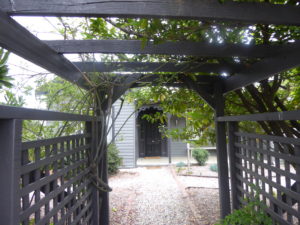
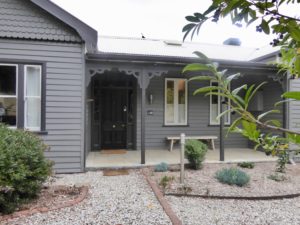
There are B&B’s and there are B&B’s, but Helmsman’s House is in a class of it’s own. We opened the door, to the sound of classical music playing, and found the most exquisitely furnished house with stunning views down over Cygnet Bay. 
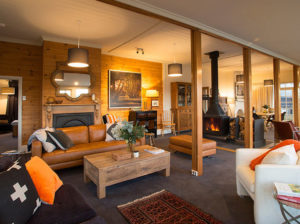
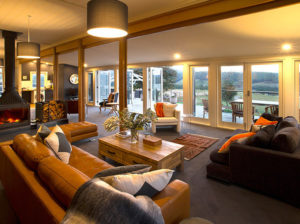
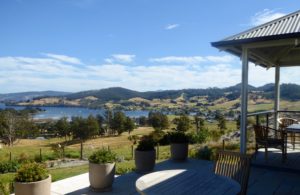 On the table in front of us was a platter of cheeses and nibbles with two wine glasses and a note saying that the wine was in the fridge. The wine was one of my favourites, a Forty Two Degree South Chardonnay from Frogmore Creek.
On the table in front of us was a platter of cheeses and nibbles with two wine glasses and a note saying that the wine was in the fridge. The wine was one of my favourites, a Forty Two Degree South Chardonnay from Frogmore Creek. 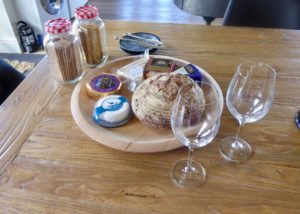
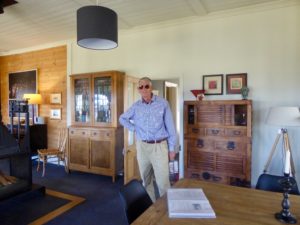
The Helmsman’s House is a spacious two-bedroom, two bathroom renovated Federation cottage. 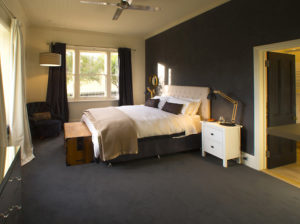
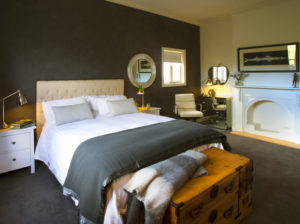 Double glazing, carpet where it counts, soft beds, deep couches and a cook’s kitchen make for a very comfortable stay.
Double glazing, carpet where it counts, soft beds, deep couches and a cook’s kitchen make for a very comfortable stay. 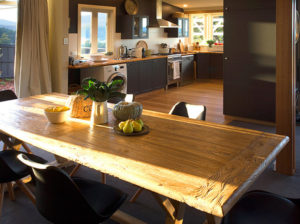 The Chimineé Philippe double-sided wood fire keeps you snug;
The Chimineé Philippe double-sided wood fire keeps you snug;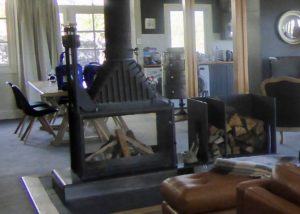 while luxurious bathrooms — each with a bath and underfloor heating plus walk-in shower —will melt tension from body and soul.
while luxurious bathrooms — each with a bath and underfloor heating plus walk-in shower —will melt tension from body and soul.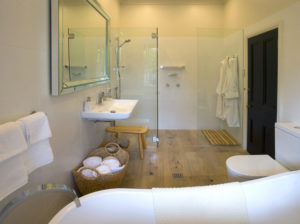 Undoubtedly the star of the well-equipped chef’s kitchen is the revolving 1917 Metters Bush Pantry. This rather eccentric object is a space-saving pantry whose drawers brim with all kinds of dry goods, sauces, oils and treats.
Undoubtedly the star of the well-equipped chef’s kitchen is the revolving 1917 Metters Bush Pantry. This rather eccentric object is a space-saving pantry whose drawers brim with all kinds of dry goods, sauces, oils and treats.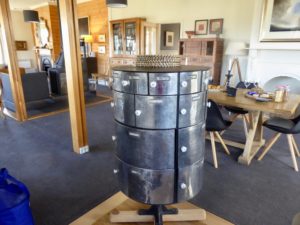 The fridge comes generously laden with seasonal and organic goodies including free-range eggs, local bacon and Tasmanian cheeses, plus artisanal Cygnet bread, milk from the dairy down the road and excellent Tasmanian butter. Tasmanian yoghurt is also provided, along with muesli and a range of breakfast cereals. Posie had even gone to the trouble of stocking lactose free milk and butter for Edgar.
The fridge comes generously laden with seasonal and organic goodies including free-range eggs, local bacon and Tasmanian cheeses, plus artisanal Cygnet bread, milk from the dairy down the road and excellent Tasmanian butter. Tasmanian yoghurt is also provided, along with muesli and a range of breakfast cereals. Posie had even gone to the trouble of stocking lactose free milk and butter for Edgar.
The vast living-dining area has French doors leading to the limestone terrace with glorious views of water, mountains and sky. Other outside areas include a pretty white-painted “folly” – a perfect place to read or meditate embraced by the bay and the hills – and a gazebo at one end of the terrace. Sundowner drinks as you watch the sunset? Why not. We took the wine and cheese platter out onto the terrace and sat in the evening light admiring the view.
We were enjoying our drinks when there was a knock on the door and Posie and Andrew were there with a chicken and tarragon casserole and blackberry and apple crumble for our dinner!
They are an interesting couple. Posie Graeme-Evans and her husband Andrew Blaxland are the creators of the award-winning, and one of Australia’s most successful, television dramas, McLeod’s Daughters. Their 80 ha farm is their version of Drovers Run, the fictional working farm featured in McLeod’s Daughters.
The name of the property is “Frenchman’s River” to celebrate the hidden French history of Australia; history that began with the arrival of French expeditions to this region over two hundred years ago. The memory of the French remains alive since they lent their names to so many places in this tiny, exquisite region. Bruni d’Entrecasteaux (Bruny Island) mapped the bay in 1792 as “Porte des Cygnes Noire” (which became Cygnet – he’d never seen black swans before). He also named the river that flows into the bay below the farm after one of his lieutenants, Huon de Kermandec.
During their first years of ownership the couple were only able to steal brief moments at the property between work schedules. Eventually they found time and space to embark on an extensive rebuild, starting with the “Picker’s Hut”, which would become Posie’s first writing sanctuary, the site from where she wrote three of her five best-selling novels, and now the ‘Writers House’. The ‘Helmsman’s House’ (named after the men who Posie considers unsung heroes) was built shortly afterwards and they are now contemplating building a third. They are generous hosts and it should be a roaring success.